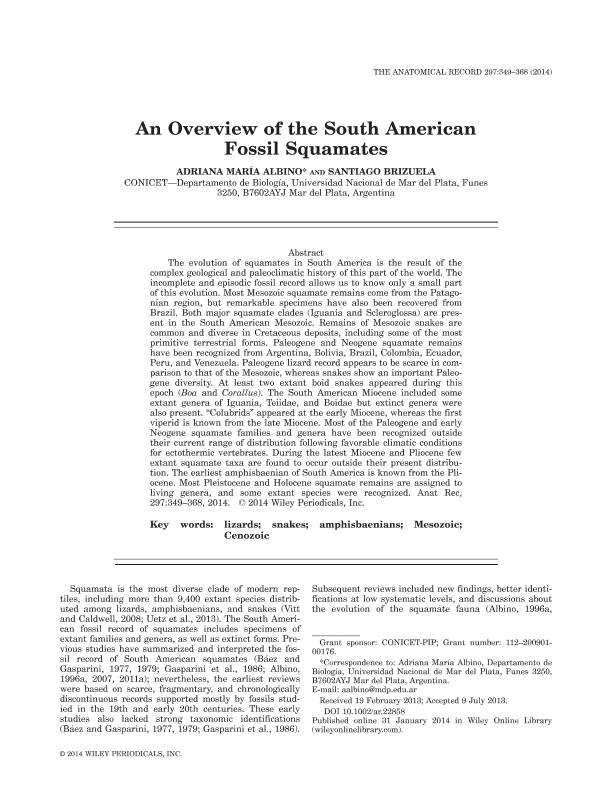Artículo
An Overview of the South American Fossil Squamates
Fecha de publicación:
03/2014
Editorial:
Veterinary and Human Toxicology
Revista:
Anatomical Record-Advances in Integrative Anatomy and Evolutionary Biology
ISSN:
1932-8486
e-ISSN:
1932-8494
Idioma:
Inglés
Tipo de recurso:
Artículo publicado
Clasificación temática:
Resumen
The evolution of squamates in South America is the result of the complex geological and paleoclimatic history of this part of the world. The incomplete and episodic fossil record allows us to know only a small part of this evolution. Most Mesozoic squamate remains come from the Patagonian region, but remarkable specimens have also been recovered from Brazil. Both major squamate clades (Iguania and Scleroglossa) are present in the South American Mesozoic. Remains of Mesozoic snakes are common and diverse in Cretaceous deposits, including some of the most primitive terrestrial forms. Paleogene and Neogene squamate remains have been recognized from Argentina, Bolivia, Brazil, Colombia, Ecuador, Peru, and Venezuela. Paleogene lizard record appears to be scarce in comparison to that of the Mesozoic, whereas snakes show an important Paleogene diversity. At least two extant boid snakes appeared during this epoch (Boa and Corallus). The South American Miocene included some extant genera of Iguania, Teiidae, and Boidae but extinct genera were also present. "Colubrids" appeared at the early Miocene, whereas the first viperid is known from the late Miocene. Most of the Paleogene and early Neogene squamate families and genera have been recognized outside their current range of distribution following favorable climatic conditions for ectothermic vertebrates. During the latest Miocene and Pliocene few extant squamate taxa are found to occur outside their present distribution. The earliest amphisbaenian of South America is known from the Pliocene. Most Pleistocene and Holocene squamate remains are assigned to living genera, and some extant species were recognized.
Palabras clave:
AMPHISBAENIANS
,
CENOZOIC
,
LIZARDS
,
MESOZOIC
,
SNAKES
Archivos asociados
Licencia
Identificadores
Colecciones
Articulos(CCT - MAR DEL PLATA)
Articulos de CTRO.CIENTIFICO TECNOL.CONICET - MAR DEL PLATA
Articulos de CTRO.CIENTIFICO TECNOL.CONICET - MAR DEL PLATA
Citación
Albino, Adriana Maria; Brizuela, Santiago; An Overview of the South American Fossil Squamates; Veterinary and Human Toxicology; Anatomical Record-Advances in Integrative Anatomy and Evolutionary Biology; 297; 3; 3-2014; 349-368
Compartir
Altmétricas




